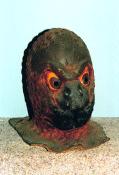|
|
|
The Mole People Universal-International's 1956 The Mole People has long taken a critical lambasting, and to be honest, it wasn't one of the studio's finer science fiction efforts, with a plot plainly inferior to that of It
Came From Outer Space and The Incredible Shrinking Man. Yet The Mole People remains today what it was when it played in theaters 45 years ago with Curucu, Beast Of The Amazon -- silly, escapist fun. The genesis of The Mole People was tied to producer William Alland's desire to make an economical film via the use of stock footage, like Columbia's It Came From Beneath The Sea, and he ended up using 287 feet from the 1953 British documentary Conquest Of Mt. Everest for the mountain climbing sequence. Laszlo Gorog’s screenplay traces the story of an archaeological expedition led by John Agar (one of sci-fi filmdom’s favorite heroes) and a pre-Leave It To Beaver Hugh Beaumont, who discover a 5,000-year-old Sumerian civilization living underground beneath Asia's Mt. Kuhitara. This albino race lords over the “Beasts of the Dark” (aka the Mole People), bulbous-eyed, hunchbacked humanoids who use their clawed hands to till the earth for their Sumerian masters. When the archaeologists befriend the Mole People, the warty slaves rise up against their oppressors and save the scientists from impending death at the hands of the Sumerians. Our heroes return to their beloved surface world moments before one of those conveniently-timed Hollywood earthquakes destroys the lost civilization. Despite a simplistic story-line, some clunker dialogue, and a lower budget and shorter production schedule than is probably needed to convince us our heroes are in a lost civilization ($429,000, filmed in just 15 days), The Mole People has its virtues. Although the Mole People are little more than masks and claws, they are one of Universal’s more indelible creations. True, their design is evolutionarily unsound, as a burrowing creature wouldn't have a hump, which would only force it to dig an even larger burrow. And the creatures’ bipedalism would cause a digger to have constant backaches. But that's not the point of monster make-up, and the Mole People work admirably from a cinematic point-of-view. Director Virgil Vogel’s film features an impressive, steamy set of the creatures' cratered living quarters, and some fanciful matte paintings and optically-inserted underwater springs lend an otherworldly atmosphere to the proceedings. The effects are not realistic, but in a pulp film like this, their fanciful nature actually adds to the enjoyment. A pseudo-ethnic score by Heinz Roemheld, Hans Salter, and Herman Stein also adds a lot of color to the proceedings. And unlike the onslaught of 1950s creatures who had little more than carnage on their beastly minds, the Mole People only kill when forced to, and in the end nobly redeem themselves with little regard for their own welfare. Surprisingly, there's something deep about The Mole People besides its subterranean setting: an anti-religious message seldom found in Hollywood movies. The film's moral is that superstitious religions lead to blindness, as the underground Sumerians refuse to believe there's anything outside of their narrow world-view. When confronted with knowledge that goes against their holy word, their only reaction is to try to destroy those who prove the fallibility of their beliefs. While religion-bashing survived the censor’s scissors (because it wasn’t a Judeo-Christian religion that was being bashed), the same couldn't be said for interracial relationships, which is no doubt why John Agar's love interest Adad (played by Cynthia Patrick) gets killed at the picture’s end. Her death doesn't serve the dramatic functions of the story, and quite frankly, they would have made an awfully cute couple. But Adad meets her demise only because according to 1950s morality, whites and Sumerians were not supposed to breed. This despite the fact that the blonde Ms. Patrick resembles a Hollywood model much more than she does a Sumerian. Would we have been better off if Universal had produced a more serious science fiction film instead of The Mole People? I'm not so sure. While The Incredible Shrinking Man and It Came From Outer Space are thought-provoking, how many movies are there where scantilly-clad albino women perform a dance of death, only to be burnt to a crisp by "The Divine Fire Of Ishtar?" Where explorers brave earthquakes and avalanches, only to be dragged beneath the Earth by burrowing creatures? And where religious narrow-mindedness is railed against in the same breath that our heroes are slipped poisonous mushrooms? The Mole People retains its considerable juvenile charm after multiple viewings. To learn about The Mole People’s thrilling music score by Herman Stein, Heinz Roemheld, and Hans Salter, click HERE.
|
|||
|
Contents of this website Copyright © 1996 - © 2024 Monstrous Movie Music. |
|||
